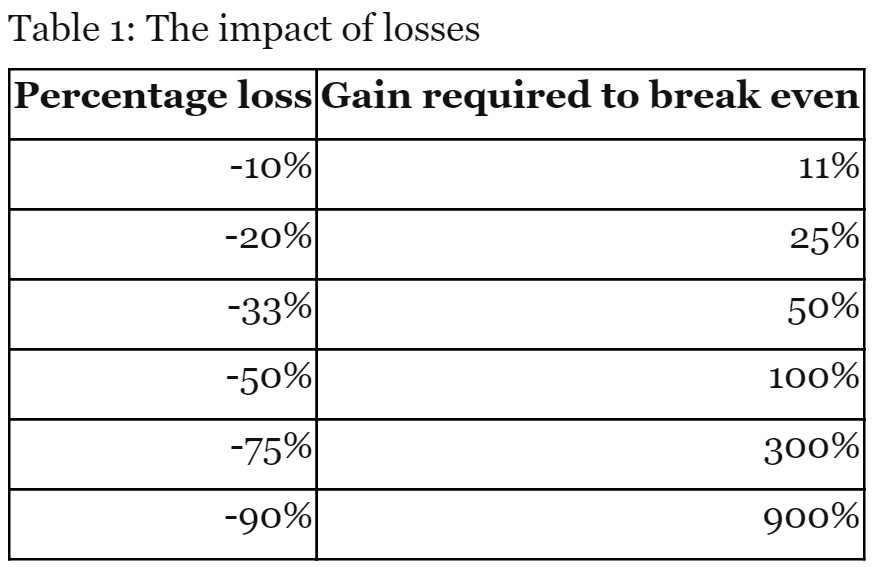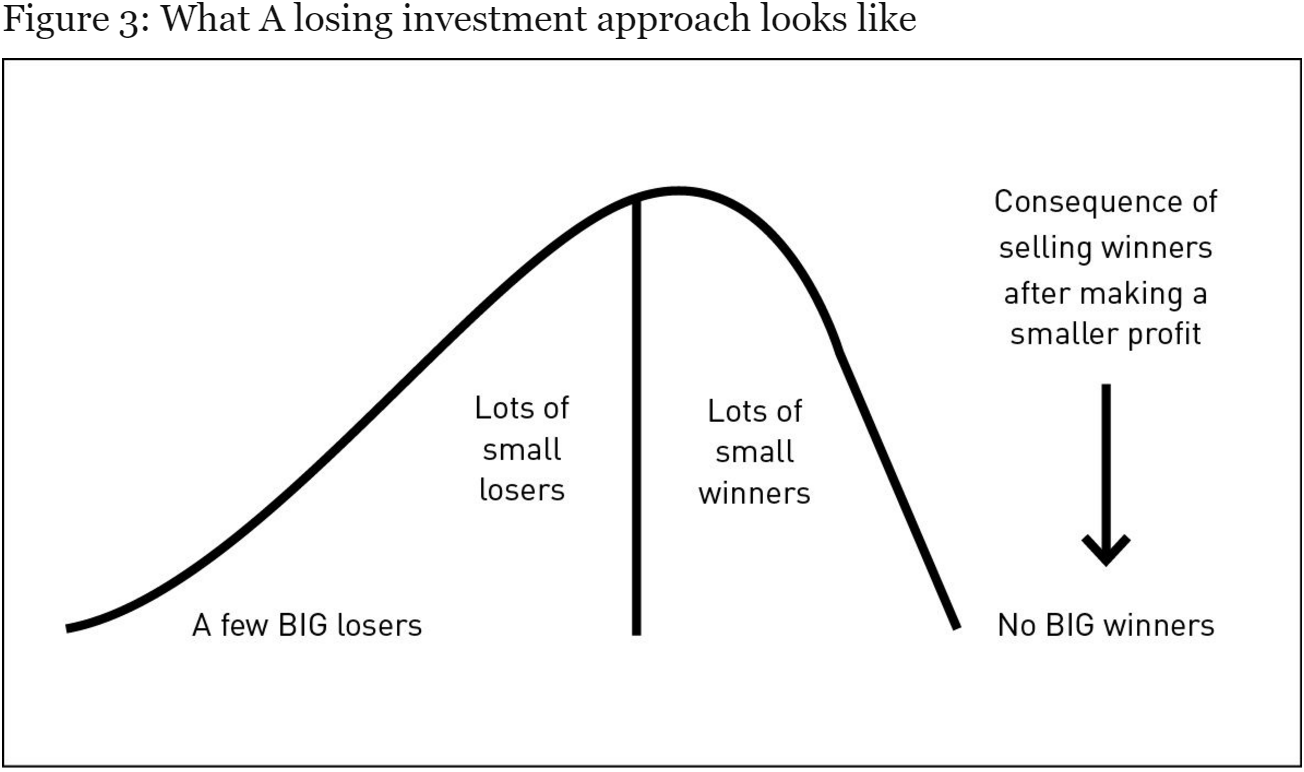The Art of Execution
Only 49% of the very best investment ideas from legendary investors made money. Despite this , they still made a lot of money
Three Investor tribes in Losing Situations
There are 3 behavior types of investors in losing situations:
1. The Rabbits/losers : Caught in the capital impairment
Mistakes made by Rabbits
- ‘Narrative Fallacy Framing Bias’
- When people make a decision they tend to reach a conclusion based on the way a problem has been presented.
- Rabbits allow their favorite type of investment to dominate how they looked at a stock.
- They also make up stories to positively explain losing situation.
- Primacy Error
- This describes the way that first impressions have a lasting and disproportional effect on a person.
- With the Rabbits, first impression is almost everything.
- Anchoring Bias
- When Rabbits change their mind, its always an aching slow process. They are unwilling to accept new findings that they were wrong about the company and should get out of the position.
- Endowment Bias
- Large losses that happen over a short duration are almost impossible to accept, especially when they are substantial. It’s easier to hold on to losing position than realize the loss by selling up.
- The rabbits cannot bear the idea of crystallizing a loss. They are too much aware of how much they paid for those losing shares.
- Try not to be anchor to the purchase prices.
- Following the Crowd
- Rabbits are rarely unique in the investments they made. Sadly, this is another reason they tended to persist with their mistake.
- Trait of conforming to peer pressure is why most investors only invest at the end of the bull run. No one wants to be seen as the fool who stood on the side while his neighbors and friends were making vast fortunes.
- The inner mental pressure to invest in stocks that you do not hold and that are going up is immense.
- You have to constantly fight the urge to sell stocks that are hurting you. Feelings of pleasure, pain and fear go a long way to explaining investor actions and omissions.
- Ego
- The Rabbits really didn’t like being wrong. In fact , ultimately they are more interested in being right than making money.
- When a rabbit defended a losing investment it reminds of Warren Buffet’s famous saying: ‘ Forecast tell you little about the future but a lot about the forecaster’
- You should expect to be wrong at least half of the time. The very best investment minds are!
- Self Attribution Bias
- Rabbits blame others or external factors for their misfortunes but take full credit when things go well. It is one of the key reasons why we don’t learn from past mistakes but keep repeating them.
- The Wrong Information
- In losing situation, Rabbit would go on a mission to seek out more information to help make the right decision. Their focus will be on finding reasons to support the original recommendation.
- Too big to fail/ Denomination Effect
- Denomination Effect : We find it easier to spend money if we have small denominations coins than when we have larger bank notes. The bigger the losing positions, the more nervous and indecisive most of us become.
- Gambler’s Fallacy
- Rabbits have a mistaken belief that the odds for a stock have become more attractive due to recent poor performance.
- It’s a belief that we will win after a streak of losses roulette at the casino.
What the Rabbits/losers could have done differently
The bad news is that everyone can be a Rabbit. The good news is , no one needs to be. There are few simple things they could have done to overcome their problems:
- Always have a Plan
- When faced with painful loss making situations, most people do nothing.
- Draw up a plan of precisely what actions you will take when your investments don’t work.
- Sell or buy more
- The only solution to a losing situation is to sell out or buy more. You have to materially adapt if you hope to survive and prosper.
- Doing nothing when you are losing is never an option.
- Don’t go all in
- Never put yourself in a situation where you find out you are still convinced by your original investment idea but are not able to invest more money when the share price falls. That is poor money management. Keep some dry powder
- Don’t be hasty to Jump in, do be hasty to jump out
- The winners make small mistake while the losers make big mistakes.
- There is a difference being ‘being right’ and ‘making money’
- Remember the saying: ‘There is nothing like an idea whose time has come.’ In investing a lot of success can be attributed to being in the right place at the right time.
- Seek out opposition
- Speak to someone with an opposing view.
- Be Humble
- Rabbits never say: ‘I don’t know’ Falling for your own hype can also lead to mistake that the least intelligent person in the world would not be capable of.
- The markets can be right even when everyone who make it up is indiviually wrong.
- Keep quiet and carry on
- Be careful who you talk to about your investments and how you talk to them. Some people have an almost religious zeal for shares they have bought and like nothing better than sharing their views in public to as many people as possible. Unfortunately, this make it impossible to walk away from an idea without looking like an idiot.
- George Soros : Theory of Reflexivity:
- Markets cannot possibly discount the future correctly because they do not merely discount the future; they also help to shape it.
-
Don’t underestimate the downside, adapt to it.
- Be open to different kinds of story
- Many studies have shown the stocks with the worst stories tend to produce the highest returns.
- Get sick of sick notes
- Familiarize yourself with all the well-worn excuse in advance so that you waste no time trying to fool yourself or anyone else persisting with a mistake. Below are some of the excuses:
- The ‘If only’ excuse
- The ‘I would have been right but for’ defense
- The ‘It just hasn’t happened yet’
- The ‘Who could have foreseen at the time I invested that XYZ would happen..’ defense
- Familiarize yourself with all the well-worn excuse in advance so that you waste no time trying to fool yourself or anyone else persisting with a mistake. Below are some of the excuses:
- Be suspicious of status
- It is dangerous to assume that just because an investment professional is highly educated and has years of experience , he or she will be good at making money and getting the big calls right.
2. The Assassins : The Art of Killing Losses
The Assassins are the investors who live and breathe Warren Buffet’s rules for investing success:
- Rule No 1 - Never Lose Money
- Rule No 2- Never Forgot Rule No 1.
When it comes to selling losing positions, Assassins are ruthless. They pull the trigger without emotion. Large losses make an overall postive return an almost impossible uphill battle. The table below shows the impact of losses
According to legendary fund manager Stanley Druckenmiller , “George Soros is one of the best loss takers”
Successful investing is about asymmetric returns. “Winning is about ensuring the upside potential is significantly greater than the downside potenital loss”
The Code of the Assassins
Here are Assassins rule for what to do in losing position:
- Kill all losers at 20-33%
- This device is the humble stop loss
- A loss of 33% requires a 50% subsequent return to break even.
- This range of stop-loss avoids you getting whipsawed while giving a realistic chance of being able to convert from the loss incurred.
- Kill Losers after a fix amount of time
- “Time is money”. Sell stocks which went down by any amount and showed no signs of recovery after a certain period of time.
- Don’t sell too soon
- One caveat is not to take this rule to extremes and start cutting losses at 5,10,15% .
The Assassins are some of the most disciplined investors.
A study by Professor Frazzini shows that highest investment returns were achieved by investors that had the highest rate of selling out of losing positions.
- Losers hang around with losers while winners hang around with winners
3. The Hunters: Pursuing Losing Shares
Like Assassins, the main reason for their success was what they did when they found themselves in losing position. Hunters have invariably contrarian style of investing.
- Hunters are successful practitioners of ‘Dollar Cost Averaging’, planning beforehand to buy more shares if a price fell.
- In gambling, such behavior is known as Martingle approach. It is frowned upon and rightly so, it leads to ruin.
- But in Well Chosen Investments this is a strategy that wins over time, you acquire more and more assets at cheaper price.
- If a stock you are invested in has fallen materially in price, but nothing else has changed, the investment thesis is still in tact, your odds will have improved significantly and you should materially increase your stake in that position.
Decision Matrix of 3 investing styles :
The above matrix clearly shows that doing nothing is never an option
I’m Winning - What Should I Do?
There are two behavior types of investors when it come to dealing with winning positions:
1. The Raiders: Snatching at Treasure
When winning you don’t want to do what the Raiders do.
Why investors sell too soon
- It feels so good
- Selling for a profit is a nice feeling. When we win, testosterone and dopamine are produced and these hormones make us feel good.
- I’m bored
- Getting tired of waiting for action is part of human nature.
- Frustration
- Nothing is truer than saying , ‘feel the pain of the gain’ when it comes to staying invested in a winning position
- Fear
- The pain of a short term loss overpowers the pleasure of a long term gain. This myopic (short-term) focus and hatred of losing is known as myopic loss aversion
- Short-term-ism
- Many people focus on short term. The technical term for this is ‘Recency bias’
- Risk Aversion
- “The prospect theory” by Kahneman and Tversky found that whether a person is winning or losing affects how they make a decision
- When losing, risk is appealing because anything is better than a certain loss
- When winning, selling is appealing because certainty of a small victory is better than uncertainty of loss of greater victory
- “The prospect theory” by Kahneman and Tversky found that whether a person is winning or losing affects how they make a decision
Why you shouldn’t sell early
- Rarity Value
- Big winners are rare. All successful investors make money because they won big in a few names, while ensuring the bad ideas did not materially hurt them.
- Stock market returns over time show kurtosis and not normal distribution/bell curve. This means that few big winners and losers distort the overall investors return.
- What a losing investment approach looks like :
-
Beat your rivals
- Honing the ability to run winners can give you a easy but significant advantage over your rivals.
- You cannot trust your next investment
- On average only 49% of top investors ideas made money.
- Winners can keep winning
- Caution : Winners may not win forever. Eventually no marginal buyers are left to bid a stock price higher and a price correction occurs.
- You can never predict big winner when you invest
- Many legendary investors did not predict their biggest winners and have admitted it.
3. The Connoisseurs : Enjoying Every Last Drop
The Connoisseurs are the most successful investment tribe.
How to ride winners
-
Find unsurprising companies
- The approach was to identify companies with a view to hold them for ten or more years. They would buy businesses that they viewed as low ‘negative surprise’ companies.
- The future growth of earnings was seen as very predictable and because Connoisseurs believed earnings growth drove stock prices, the stock prices drift higher over times.
- Look for big potential upside
- Any investment idea should have very good upside potential. They just weren’t interested in small scale success.
- Invest Big and Focus
- When connoisseurs were very confident in an idea, they build up big positions
- Don’t’ be scared
- One of the keys to riding a big winner is to avoid being scared out of it.
- The way many Connoisseurs avoided being scared out of a position or being attracted away by another great investment was to take small profits as the stock kept going up rather than selling entirely out of the position.
- Make sure you have a pillow
- One of key requirements of staying invested in a big winner is to have (or cultivate) a high boredom threshold.
- Many of us , seeing we have made a profit of 40% in one of our stocks, start actively looking for another company to invest the money into.
- Dealing with Losses
- Despite their successful approach, only one in three of Connoisseurs’ ideas made money. In other words, every Connoisseur was also an assassin or a hunter when it came to losses.
Dangers of being a Connoisseurs
Being a Connoisseurs is not easy. It also comes with some significant dangers that must be watched for
- You can be too late.
- Ned Davis, using Down Jones Industrial average from 1929 to 1998 showed that: THe bulk of investors returns (more or less half) in bull markets come in the first third of a rally.
- He also showed that first half of a rally accounts for two-thirds of the overall return in bull market.
- Momentum can be illusory- and end abruptly
- The longer a stock has been winning, and the more widespread its story has become, the more speculators will have bought into it with the view to own for it as long as ‘trend is your friend’
- You can get stuck
- Ned Davis made a brilliant remark about the dangers of crowded trades. Its like someone shouting fire in a crowded movie theater. Panic breaks and people can be crushed rushing for the exits
- Taking some profit over the years is a good idea.
Checklists
The Winner’s Checklist : The five winning habits of investment titans
- Best Ideas only
- Invest in a handful of your very best ideas
- Position Size Matters
- Be prepared to invest big-just don’t go all in on day one.
- Be greedy when winning
- Give your investment the possibility of growing into ‘10 baggers’
- Materially adapt when you are losing
- Either add meaningfully to an existing investment or sell out.
- Only invest in liquid stocks
- Make sure stock is liquid enough to execute your idea. There is nothing worse than knowing what to do , wanting to do it, but being unable to do it.
The Loser’s Checklist: The five losing habits of most investors
- Invest in lots of ideas
- Invest a small amount in each idea
- You are effectively picking up pennies in front of an oncoming train.
- Take small profits
- Stay in an investment idea and refuse to adapt when losing
- Do not consider liquidity





Leave a Comment